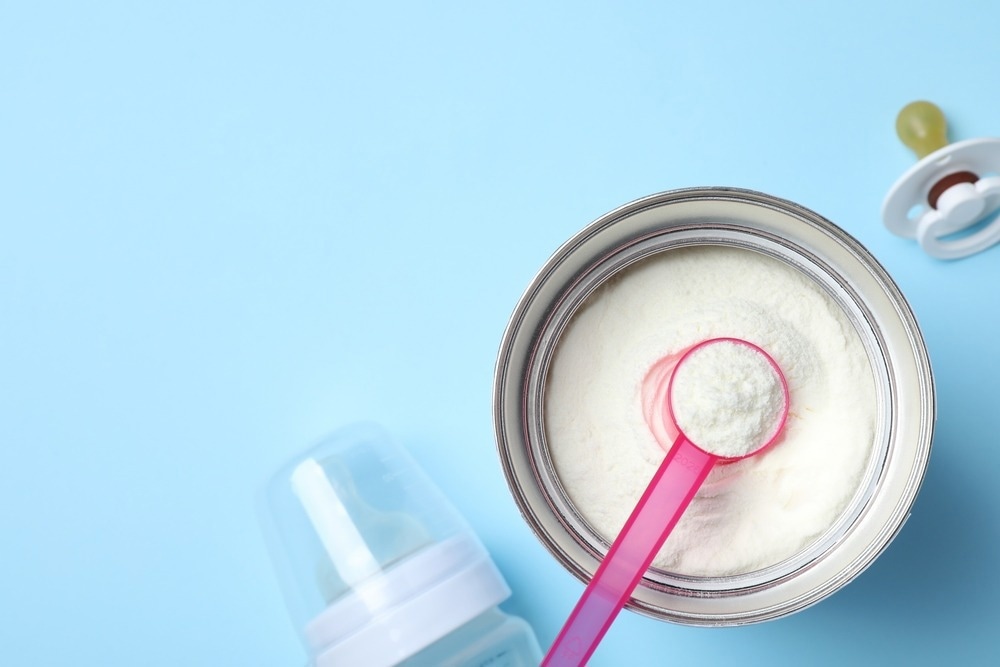In a recent study published in the United States (U.S.) Centers for Disease Control and Prevention’s (CDC) Morbidity and Mortality Weekly Report, researchers reported two cases of Cronobacter sakazakii infections related to contaminations in breast pump equipment and infant formula powder.
 Study: Cronobacter sakazakii Infections in Two Infants Linked to Powdered Infant Formula and Breast Pump Equipment — United States, 2021 and 2022. Image Credit: New Africa/Shutterstock
Study: Cronobacter sakazakii Infections in Two Infants Linked to Powdered Infant Formula and Breast Pump Equipment — United States, 2021 and 2022. Image Credit: New Africa/Shutterstock
Background
Cronobacter sakazakii belongs to the family Enterobacteriaceae and is a gram-negative bacteria species that cause severe and sometimes fatal sepsis and meningitis in infants. Most C. sakazakii infections have been traced back to contaminations in the infant formula powder or breast milk pumped using contaminated equipment. Outbreak investigations have detected C. sakazakii in breast pump components, home surfaces, opened formula boxes, and sometimes in unopened containers of powdered formula and manufacturing facilities.
About the study
In the present study, the CDC detected two cases of C. sakazakii contaminations using whole genome sequencing analysis. Cases of C. sakazakii infections in two infants, patients A and B, were reported in September 2021 and February 2022, respectively. Environmental samples and patient isolates were provided to the public health laboratories, federal agencies, and the CDC for identification and whole genome sequence analysis.
Patient A was a male infant born through vaginal delivery, and the mother was healthy with an uncomplicated pregnancy. At two weeks, the infant presented with excessive crying, irritability, fever, diaper dermatitis, and oral candidiasis. He had been fed powdered formula, and breast milk expressed using a pump. Lumbar puncture analysis revealed C. sakazakii in the cerebrospinal fluid. Intravenous antibiotic treatment resulted in complete recovery with no sequelae.
Patient B was also a male infant, but he was born preterm through cesarean section due to the mother experiencing preeclampsia and breech presentation. Neonatal intensive care treatment after premature birth stabilized the infant and he no longer required respiratory support. The infant was given expressed breast milk with a fortifier using an orogastric tube.
At 20 days, the infant suffered from episodes of apnea and bradycardia, and fever, followed by seizures, and required respiratory support. Blood and cerebrospinal fluid samples revealed the presence of C. sakazakii. The infant died after 13 days of onset of illness despite intravenous antibiotic treatment and subsequent negative blood cultures.
Results
The results from the analysis of environmental and patient isolates in the case of patient A revealed C. sakazakii contamination in the opened formula powder and the water container that was used to prepare the formula. Whole genome sequence analysis comprising high-quality analysis of single nucleotide polymorphisms revealed two distinct C. sakazakii strains, with the strain from the patient isolate being closely related to that from the can of formula powder and the second strain linking the powdered formula can to the water container. Investigation of unopened cans of formula powder from the same manufacturing lot revealed no C. sakazakii contamination.
In the case of patient B, C. sakazakii contamination was identified in the parts of the breast milk pump used at home. Still, no bacterial presence was detected in the expressed milk, samples of human milk fortifier, breast pump used in the hospital, or the unopened cans of formula powder in the hospital.
Whole genome sequence analysis revealed that the C. sakazakii strain from the patient isolate was closely related to the strain found in the home breast milk pump. It was reported that the breast milk pump was cleaned and sanitized in the household sink and sometimes reassembled before completely drying.
The unrelated nature of contamination in the two cases highlights the ubiquity of C. sakazakii and emphasizes the need for stringent hygiene protocols. Cronobacter sakazakii infections leading to meningitis have a 40% mortality rate, and infants who survive severe infections often experience neurological sequelae stemming from hydrocephalus and cerebral abscesses.
Estimates reveal that every year, approximately 18 cases of C. sakazakii occur in the U.S., and all of these are most likely due to contamination during formula preparation or in the equipment used at home to express milk or prepare the formula. Cronobacter sakazakii has been found in pacifiers, baby bottles, kitchen sinks, and vacuum cleaner bags. Formula scoops could also possibly get contaminated from contact with the countertops during formula preparation.
Conclusions
Overall, the findings indicate that C. sakazakii bacteria are common in the environment, and protocols for safe and hygienic food preparation for infants are essential. Thorough cleaning and sanitization of the equipment used to express and store breast milk are also important.
Journal reference:
- Haston, J. C., Miko, S., Cope, J. R., McKeel, H., Walters, C., Joseph, L. A., Griswold, T., Katz, L. S., Andújar, A. A., Tourdot, L., Rounds, J., Vagnone, P., Medus, C., Harris, J., Geist, R., Neises, D., Wiggington, A., Smith, T., Im, M. S., & Wheeler, C. (2023). Cronobacter sakazakii Infections in Two Infants Linked to Powdered Infant Formula and Breast Pump Equipment — United States, 2021 and 2022. MMWR. Morbidity and Mortality Weekly Report, 72(9), 223–226. doi: https://doi.org/10.15585/mmwr.mm7209a2 https://www.cdc.gov/mmwr/volumes/72/wr/mm7209a2.htm?s_cid=mm7209a2_w